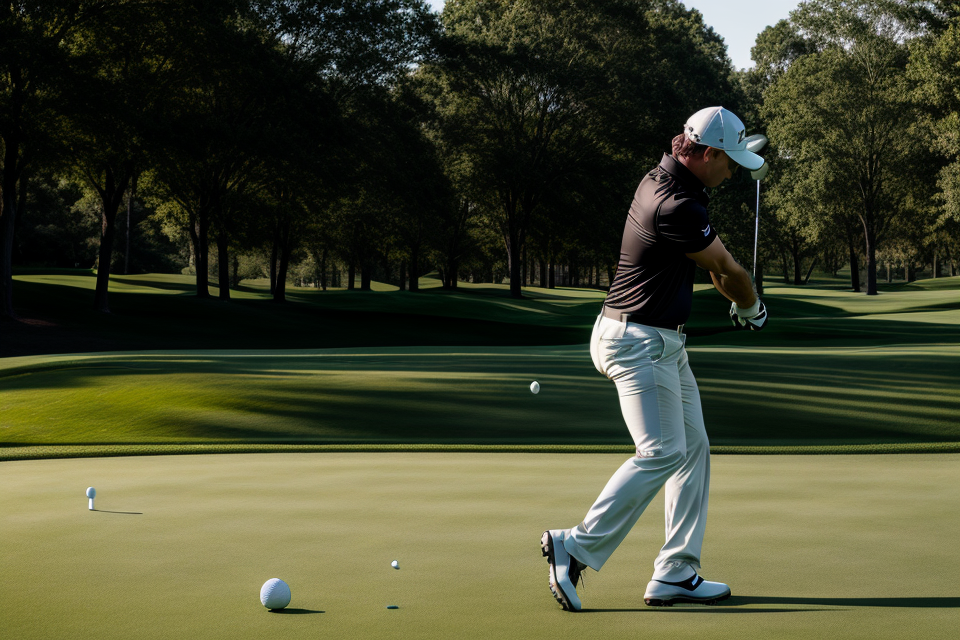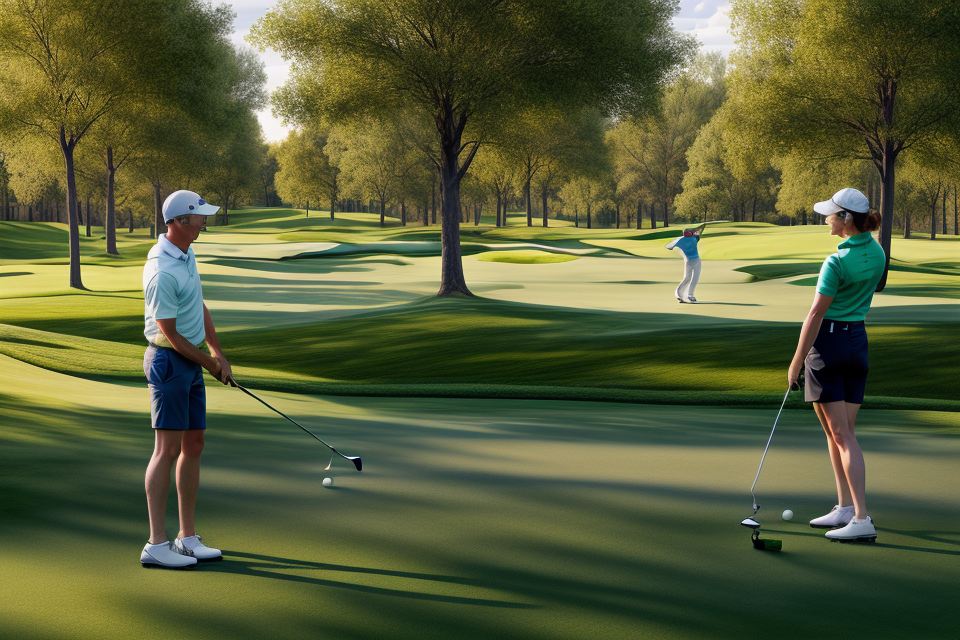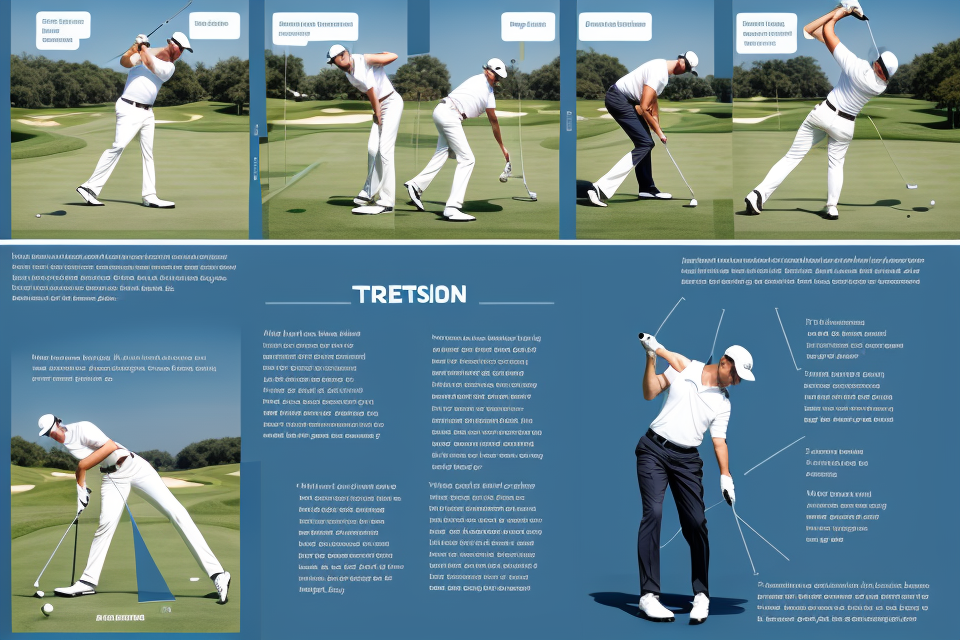
Golf is a game that requires precision, control, and a smooth swing. But what is the real swing method in golf? Many golfers struggle with this question, and it’s not surprising. There are many different swing methods, each with its own unique techniques and philosophies. In this article, we will explore the different types of swing methods, what they entail, and what makes them effective. We will also look at some of the most famous golfers who have used these methods to achieve success on the course. So, whether you’re a beginner or an experienced golfer, read on to discover the real swing method in golf.
The Real Swing Method in Golf is a golf swing technique that emphasizes the importance of maintaining a stable lower body while rotating the upper body. This method encourages golfers to use their legs and hips to generate power, rather than their arms and shoulders. The Real Swing Method also teaches golfers to keep their spine angle constant throughout the swing, which helps to maintain a smooth and balanced motion. By focusing on these key elements, golfers can improve their swing mechanics and increase their distance and accuracy on the course.
Understanding the Golf Swing
The Mechanics of a Proper Golf Swing
Golf is a game that requires precision and accuracy, and the swing is the most crucial aspect of the game. A proper golf swing involves a series of movements that must be executed with perfect timing and coordination. In this section, we will delve into the mechanics of a proper golf swing and discuss the various elements that contribute to a successful swing.
Grip
The grip is the first point of contact between the golfer and the club. A correct grip is essential for a powerful and accurate swing. The most common grip used by golfers is the overlapping grip, where the little finger of the left hand overlaps the right hand’s index finger. The grip should be firm but not too tight, allowing for natural wrist hinging during the swing.
Stance
The stance is the position of the golfer’s feet during the swing. A proper stance is essential for balance and stability, allowing the golfer to make a smooth and powerful swing. The feet should be shoulder-width apart, with the front foot slightly pointing towards the target. The knees should be slightly bent, and the weight should be distributed evenly on both feet.
Posture
Posture is critical in a golf swing, as it affects the golfer’s balance and the ability to make a powerful and accurate swing. The golfer should stand upright, with the shoulders relaxed and the spine in a neutral position. The head should be up, and the eyes should be focused on the ball. The arms should be relaxed, and the hands should be positioned correctly on the club.
Arm Swing
The arm swing is an essential component of the golf swing, as it contributes to the power and accuracy of the shot. The arms should be relaxed and extended during the backswing, allowing for a full extension of the muscles. The wrists should hinge naturally during the downswing, adding power to the shot. The arms should be bent slightly during the impact, allowing for a smooth and accurate shot.
Body Turn
The body turn is the rotation of the torso during the swing, and it is an essential element of a proper golf swing. The golfer should rotate the torso away from the target during the backswing, allowing for a full extension of the muscles. The rotation should be smooth and controlled, with the hips and shoulders turning simultaneously. The golfer should then rotate back towards the target during the downswing, adding power to the shot.
In conclusion, the mechanics of a proper golf swing involve several elements that must be executed with precision and coordination. The grip, stance, posture, arm swing, and body turn are all critical components of a successful swing, and mastering these elements is essential for any golfer looking to improve their game.
Common Mistakes in Golf Swing Technique
Golf swing technique is an essential aspect of the game, and many players often make common mistakes that affect their performance. These mistakes can lead to a loss of power, accuracy, and consistency in shots. In this section, we will discuss some of the most common mistakes in golf swing technique and how to avoid them.
Overuse of the arms
One of the most common mistakes in golf swing technique is the overuse of the arms. Many players tend to use their arms too much during the swing, which leads to a loss of power and control. The correct technique is to use the larger muscles in the body, such as the legs and core, to generate power and control the club.
Swaying or tilting
Another mistake that many players make is swaying or tilting their bodies during the swing. This can lead to a loss of balance and control, resulting in inaccurate shots. The correct technique is to keep the body in a balanced position throughout the swing, with the weight shifted onto the back foot during the backswing and the front foot during the downswing.
Lack of hip rotation
A lack of hip rotation is another common mistake in golf swing technique. Many players fail to rotate their hips properly, which can lead to a loss of power and control. The correct technique is to rotate the hips in a smooth and controlled manner, using the legs and core to generate power.
Early extension of the arms
Early extension of the arms is another mistake that can affect the accuracy and power of shots. Many players tend to extend their arms too early in the swing, which can lead to a loss of control and power. The correct technique is to keep the arms extended throughout the swing, using the larger muscles in the body to generate power and control.
Lack of balance
A lack of balance is another common mistake in golf swing technique. Many players fail to maintain their balance throughout the swing, which can lead to inaccurate shots. The correct technique is to maintain a balanced position throughout the swing, with the weight shifted onto the back foot during the backswing and the front foot during the downswing.
In conclusion, these are some of the most common mistakes in golf swing technique, and it is essential to avoid them to improve your performance on the course. By focusing on proper technique and avoiding these mistakes, you can generate more power and control in your shots, resulting in more accurate and consistent results.
The Misconceptions About the Golf Swing
A proper golf swing involves several elements that must be executed with precision and coordination. The grip, stance, posture, arm swing, and body turn are all critical components of a successful swing. Golfers must avoid common mistakes in swing technique, such as overuse of the arms, swaying or tilting, lack of hip rotation, and early extension of the arms. Additionally, every golfer is unique, and what works for one player may not work for another. Therefore, it’s important to receive personalized instruction from a qualified golf professional who can help them develop a swing that is tailored to their individual needs and abilities.
The Myth of a “Perfect” Swing
One of the most pervasive myths in golf is the idea of a “perfect” swing. Many golfers believe that there is a single, ideal swing method that will guarantee success on the course. However, this is simply not the case.
- Every golfer is unique
Every golfer has a unique body type, swing style, and physical abilities. What works for one golfer may not work for another. Therefore, it’s important to understand that there is no one-size-fits-all approach to the golf swing.
- No single swing method fits all
Golf is a highly individualized sport, and the swing is no exception. Each golfer must find the swing method that works best for them, based on their own physical attributes and playing style. A professional instructor can help a golfer determine the best swing method for them, but ultimately, it’s up to the golfer to make the adjustments necessary to improve their game.
- Importance of individualized instruction
While there is no single “perfect” swing method, professional instruction can be incredibly valuable in helping golfers find the swing that works best for them. A qualified instructor can analyze a golfer’s swing, identify any flaws or weaknesses, and provide personalized guidance on how to improve. With the right instruction and practice, any golfer can develop a swing that allows them to perform at their best on the course.
The Myth of a “One-Size-Fits-All” Swing Technique
One of the most pervasive myths in golf is the idea that there is a single, universal swing technique that will work for every golfer, regardless of their physical attributes, skill level, or playing style. Unfortunately, this is simply not true. While there are certain fundamental principles that apply to all golf swings, the fact is that every golfer is unique, and what works for one player may not work for another.
- The Importance of Personalized Instruction
Golf is a highly technical sport, and there is a vast array of swing techniques and strategies that can be used to achieve success on the course. Because of this, it is essential for golfers to receive personalized instruction from a qualified golf professional who can help them develop a swing that is tailored to their individual needs and abilities.
A good instructor will take into account a golfer’s physical attributes, such as their height, weight, and body type, as well as their swing mechanics, ball flight, and on-course performance. They will also consider the golfer’s goals and aspirations, as well as any physical limitations or injuries that may affect their swing.
- Swing Changes Over Time
Another reason why a “one-size-fits-all” swing technique is a myth is that golfers’ swings change over time as they develop and improve their skills. As golfers become more proficient, they may need to make adjustments to their swing in order to maintain their accuracy and distance. For example, a golfer who is initially taught to swing with a hands-on approach may need to switch to a more arm-and-body-driven swing as they get stronger and more experienced.
Similarly, a golfer who starts out with a powerful, sweeping swing may need to adopt a more controlled, compact swing as they get older or if they experience injuries. The key is to be flexible and open to making changes as needed, rather than sticking rigidly to a single, predetermined swing technique.
- Adapting to Different Course Conditions
Finally, the idea that there is a single, universal swing technique is also belied by the fact that golf courses can vary widely in terms of their layout, hazards, and other features. In order to succeed on different courses, golfers need to be able to adapt their swings to suit the specific conditions they are facing.
For example, a golfer who is used to playing on wide-open courses may need to adjust their swing when faced with narrow fairways or dense rough. Similarly, a golfer who is accustomed to playing in dry, sunny conditions may need to modify their swing when playing in wet or windy weather.
In conclusion, while there are certain fundamental principles that apply to all golf swings, the idea that there is a single, universal swing technique that will work for every golfer is a myth. Golfers need to receive personalized instruction, be open to making changes over time, and be able to adapt their swings to suit different course conditions in order to achieve success on the course.
The Fundamentals of a Good Golf Swing
Balance and Body Positioning
- The role of balance in power and accuracy
Balance is crucial in golf as it enables the golfer to maintain control over the club and to make precise shots. A balanced stance allows for a smooth transfer of weight and a consistent swing motion. The ability to balance one’s body throughout the swing is directly related to the accuracy and power of the shot. - The importance of weight distribution
Weight distribution plays a vital role in the golf swing. Golfers must distribute their weight evenly on both feet during the backswing and shift their weight to the front foot during the downswing. This allows for proper control and balance throughout the swing, leading to improved accuracy and power. - The connection between posture and swing mechanics
Posture is closely related to swing mechanics in golf. A proper posture helps to maintain balance and control during the swing. Golfers with a strong posture are able to control their movements more effectively, resulting in a more efficient and accurate swing. Additionally, maintaining a proper posture throughout the swing helps to prevent fatigue and strain on the body.
Proper Alignment and Aim
Understanding the golf ball’s trajectory
The trajectory of a golf ball is determined by a variety of factors, including the speed and spin rate of the ball, the angle of the clubface at impact, and the loft of the club. Understanding the trajectory of the ball is crucial for accurate aiming, as it will affect how the ball moves through the air and how much it will curve or dip.
The importance of alignment for accuracy
Proper alignment is essential for accuracy in golf. The golfer should stand with their feet shoulder-width apart, with the ball positioned slightly forward of their front foot. The golfer’s shoulders, hips, and feet should all be square to the target line, with the clubface also square to the target. This alignment ensures that the golfer’s body is in the correct position to make a powerful and accurate swing.
The role of aim in maintaining consistency
Aim is crucial in golf, as it helps the golfer to maintain consistency in their shots. The golfer should pick a spot on the target where they want the ball to land, and then align their body and club accordingly. Maintaining a consistent aim throughout the round will help the golfer to hit the ball accurately and avoid wandering shots.
Proper alignment and aim are crucial for a good golf swing. By understanding the trajectory of the ball, aligning the body and club correctly, and maintaining a consistent aim, golfers can improve their accuracy and consistency on the course.
Using Your Body for Power and Accuracy
The connection between the body and the golf swing is a crucial aspect that is often overlooked by many golfers. It is important to understand that the body plays a vital role in generating power and accuracy in the golf swing.
Using the hips and torso for power is one of the key fundamentals of a good golf swing. The hips and torso are the primary sources of power in the swing, and they work together to generate speed and force. The hips should be used to rotate the upper body, while the torso should be used to keep the swing on plane.
Maintaining control through the swing is also crucial in using the body for power and accuracy. Golfers must maintain control of their body throughout the swing to ensure that they are able to generate power and accuracy. This means keeping the head still, maintaining a steady rhythm, and using the correct muscles to control the swing.
Additionally, golfers should focus on maintaining a proper alignment throughout the swing. This includes keeping the spine aligned with the target line and the feet pointing in the right direction. By doing so, golfers can maximize the power and accuracy of their swing while minimizing the risk of injury.
In conclusion, using the body for power and accuracy in the golf swing is essential for success on the course. Golfers must focus on the connection between the body and the swing, use the hips and torso for power, maintain control throughout the swing, and maintain proper alignment. By mastering these fundamentals, golfers can improve their power and accuracy on the course.
Developing a Personalized Swing Method
Seeking Professional Instruction
The value of lessons from PGA professionals
Lessons from PGA professionals are an invaluable resource for golfers looking to improve their swing. These professionals have spent years studying the game and perfecting their own swings, and they can offer valuable insights and feedback to help golfers identify and correct flaws in their own technique. Additionally, PGA professionals can provide personalized instruction tailored to the individual golfer’s needs and goals, ensuring that they are working on the most effective swing adjustments.
Video analysis and swing assessments
Video analysis is a popular tool used by PGA professionals to help golfers improve their swings. By recording a golfer’s swing and analyzing it frame by frame, a professional can identify areas of the swing that need improvement and provide targeted feedback. This approach allows golfers to see their swing from a different perspective and can help them better understand the mechanics of their swing.
Regular practice and drills
Regular practice is essential for improving any skill, including golf. Golfers who seek professional instruction should be prepared to commit to regular practice and drills to see improvements in their swing. PGA professionals can provide guidance on the most effective drills and practice routines to help golfers develop a consistent and repeatable swing. Additionally, regular practice can help golfers build muscle memory, making it easier to repeat their swing under pressure on the golf course.
Practicing with Purpose
As a golfer, developing a personalized swing method is crucial to achieving success on the course. One important aspect of this process is practicing with purpose. By breaking down the swing into components and focusing on key fundamentals, golfers can develop a pre-shot routine that will help them perform at their best when it matters most.
Breaking Down the Swing into Components
Practicing with purpose means breaking down the golf swing into its individual components. This allows golfers to focus on specific aspects of the swing, such as the takeaway, backswing, and downswing. By isolating these components, golfers can identify and correct any issues that may be affecting their overall swing.
Focusing on Key Fundamentals
In addition to breaking down the swing into components, practicing with purpose also involves focusing on key fundamentals. These fundamentals include things like grip, stance, and posture. By focusing on these essential elements of the swing, golfers can build a strong foundation for their swing and improve their overall performance.
Developing a Pre-Shot Routine
Developing a pre-shot routine is another important aspect of practicing with purpose. This routine should include elements such as visualization, relaxation techniques, and physical movements that help to prepare the golfer for the shot. By developing a pre-shot routine, golfers can improve their focus and reduce their anxiety on the course.
Overall, practicing with purpose is an essential part of developing a personalized swing method in golf. By breaking down the swing into components, focusing on key fundamentals, and developing a pre-shot routine, golfers can improve their swing and achieve success on the course.
Continuously Evolving Your Swing
Adapting to changing course conditions
Golf courses can be challenging and unpredictable, with changing weather conditions, wind speeds, and even the condition of the greens. To succeed in golf, it’s crucial to adapt your swing to these changing conditions. For example, if the wind speed increases, you may need to adjust your ball flight to compensate for the wind’s impact on the ball’s trajectory. This might involve making adjustments to your grip, stance, or body positioning to maintain control over your shots.
Addressing weaknesses and improving strengths
No golfer is perfect, and everyone has their own set of strengths and weaknesses. However, the key to becoming a better golfer is to continuously work on improving your weaknesses while maintaining and building on your strengths. This might involve practicing specific aspects of your swing, such as your backswing or follow-through, or focusing on developing a more consistent ball-striking technique.
One effective way to address weaknesses and improve strengths is to seek the guidance of a professional golf coach or instructor. A coach can help you identify areas where you need to improve, provide personalized feedback and guidance, and develop a customized practice routine that’s tailored to your individual needs and goals.
Staying focused on the fundamentals
Despite the many variations in golf swings, there are certain fundamental principles that all successful golfers have in common. These fundamentals include maintaining a balanced and athletic posture, keeping your head down and eyes focused on the ball, using a smooth and rhythmic swing, and making solid contact with the ball.
To continue improving your swing, it’s essential to stay focused on these fundamental principles and incorporate them into your practice routine. This might involve practicing your grip, stance, and alignment, or working on developing a more consistent and fluid swing motion. By focusing on the fundamentals, you can build a strong foundation for your swing and make consistent progress towards your golfing goals.
FAQs
1. What is the real swing method in golf?
The real swing method in golf is a technique that emphasizes the importance of the kinematic sequence, which is the natural order of the body’s movements during the golf swing. This method focuses on maintaining the proper alignment, balance, and rhythm throughout the swing, which can help golfers improve their accuracy, distance, and consistency.
2. What are the key elements of the real swing method?
The key elements of the real swing method include maintaining a proper grip on the golf club, using the legs and hips to initiate the swing, keeping the head and eyes focused on the target, and using the wrists and arms to control the clubhead throughout the swing. Additionally, the real swing method emphasizes the importance of the body’s natural movements and avoiding excessive tension or movement.
3. How can I improve my swing using the real swing method?
To improve your swing using the real swing method, start by focusing on the basic mechanics of the swing, such as maintaining a proper grip and stance. Then, practice swinging the club in a controlled manner, focusing on the kinematic sequence and keeping your body aligned and balanced throughout the swing. It’s also important to practice regularly and receive feedback from a golf instructor to help you make any necessary adjustments to your swing.
4. What are some common mistakes to avoid when using the real swing method?
Some common mistakes to avoid when using the real swing method include gripping the club too tightly, overusing the arms and shoulders, and losing alignment and balance during the swing. It’s also important to avoid getting too focused on your lower body movements and neglecting the role of the upper body in the swing.
5. Can the real swing method be used by golfers of all skill levels?
Yes, the real swing method can be used by golfers of all skill levels, from beginners to professionals. The method emphasizes the importance of natural body movements and proper alignment, which can be beneficial for golfers at any level. However, it’s important to note that more advanced golfers may need to make more technical adjustments to their swing in order to achieve optimal results.


